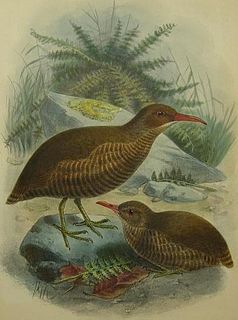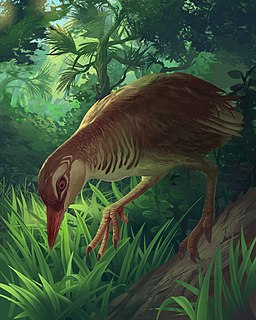
The Marquesas Islands are a group of volcanic islands in French Polynesia, an overseas collectivity of France in the southern Pacific Ocean. Their highest point is the peak of Mount Oave on Ua Pou island, at 1,230 m (4,035 ft) above sea level.

The rails, or Rallidae, are a large cosmopolitan family of small- to medium-sized, ground-living birds. The family exhibits considerable diversity and includes the crakes, coots, and gallinules. Many species are associated with wetlands, although the family is found in every terrestrial habitat except dry deserts, polar regions, and alpine areas above the snow line. Members of the Rallidae occur on every continent except Antarctica. Numerous island species are known. The most common rail habitats are marshland and dense forest. They are especially fond of dense vegetation.

Tahuata is the smallest of the inhabited Marquesas Islands, in French Polynesia, an overseas territory of France in the Pacific Ocean. It is located 4 km (2.5 mi.) to the south of the western end of Hiva Oa, across the Canal du Bordelais, called Ha‘ava in Marquesan.

Gallirallus is a genus of rails that live in the Australasian-Pacific region. The genus is characterised by an ability to colonise relatively small and isolated islands and thereafter to evolve flightless forms, many of which became extinct following Polynesian settlement.

The conquered lorikeet is a species of parrot that became extinct 700–1300 years ago. It lived in islands of Polynesia. David Steadman and Marie Zarriello wrote its species description in 1987.
The Marquesan kingfisher or Marquesas kingfisher is a species of bird in the family Alcedinidae. It is endemic to French Polynesia. It is threatened by habitat loss and predation by introduced species, and is currently classified as Critically endangered, with fewer than 500 individuals left in the wild.

The Chatham rail is an extinct flightless species of bird in the family Rallidae. It was endemic to Chatham, Mangere and Pitt Islands, in the Chatham archipelago of New Zealand.
The Marquesan monarch is a species of bird in the family Monarchidae. It is endemic to French Polynesia. Its natural habitats are subtropical or tropical dry forest, subtropical or tropical moist lowland forest, and subtropical or tropical moist montane forest. It is threatened by habitat loss.
The Huahine rail was a species of bird in the family Rallidae. It was a medium-sized Gallirallus rail endemic to Huahine in the Society Islands of French Polynesia. It is known only from subfossil remains found at the Fa'ahia archaeological site on the island. Fa'ahia is an early Polynesian occupation site with radiocarbon dates ranging from 700 CE to 1200 CE. The rail is only one of a suite of birds found at the site which became extinct either locally or globally following human occupation of the island.
The great ground dove is an extinct species of bird in the family Columbidae. It was found in Mangaia in the southern Cook Islands, and in French Polynesia where subfossil bones between 1000 and 2000 years old have been found in the Marquesas, as well as between 750 and 1250 years old at the Fa'ahia early occupation site on Huahine in the Society Islands.
The Tubuai rail is an extinct species of flightless bird in the Rallidae, or rail family.
The Ua Huka rail is an extinct species of flightless bird in the Rallidae, or rail family.
The Nuku Hiva rail is an extinct species of flightless bird in the Rallidae, or rail family.
The Niue rail is an extinct species of flightless bird in the Rallidae, or rail family.
The Mangaia rail is an extinct species of flightless bird in the rail family, Rallidae.

The ʻEua rail is an extinct species of flightless bird in the Rallidae, or rail family. It was described in 2005 from subfossil bones found on the island of ʻEua, in the Kingdom of Tonga of West Polynesia.

The Tongatapu rail was a species of bird in the family Rallidae. It was apparently native to the island of Tongatapu in the Kingdom of Tonga, in Polynesia in the south-west Pacific Ocean. It is known only from brief descriptions of a specimen, now lost, collected from Tongatapu in 1777 in the course of James Cook's third voyage to the Pacific, and from a contemporary illustration by Georg Forster.

Astolfo's rail is an extinct species of flightless bird in the Rallidae, or rail family. It lived in Rapa Iti, one of the Bass Islands in French Polynesia.








